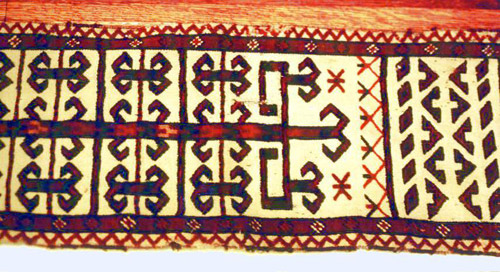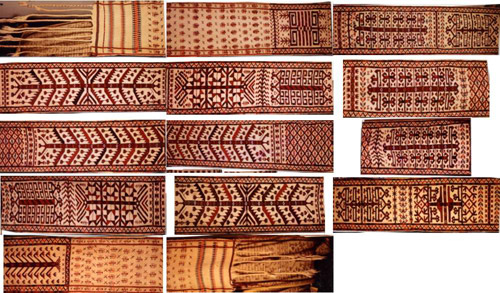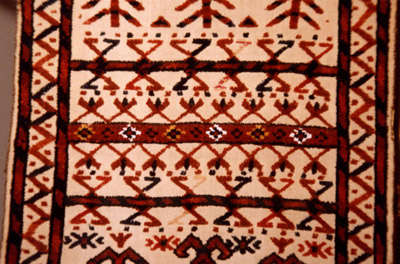Posted by Lavergne Philippe on 06-26-2003 06:50 PM:
A few pictures
It is near to be impossible to make an idea about the quality with pictures..
So, I try to do it with mines ( some of them are very bad..)
For exemple


( about 20 cm wide ) is
the tightest I have seen : in the hands, it looks silky
For me, it is very
old. I have very close pictures too.


( about 20 cm ) one of
the two pictures of the same band is good
( I have not the previous with
me, so I can’t look for offset knotting . I have the next ones, and it seems to
me that Off.Knot. exists everywhere



( 30-32 x 1200 cm
about ) bad pictures-
is very nice, and very close of Azadi's so called Saryk
in " Blumen in der Wüste "N° 107 : why Saryk ?
Very few silk ( blue white
and red) and some cotton.. You can see cotton, white and some red silk on the
detailed picture.
Wool very short. Very colourful. Selvedge made with two
tiny yarns of brown wool

( 108 x 32 and 190 x 36
cm) two fragments of two bands : coarse, but nice colors, typically yomud, not
very smart
We have to appreciate too the height of the wool, quite
different from one band to another one.
I saw too a cotton band ( wool
on cotton , wide about 35 ) , probably Karakalpak, if I do not mistake, and I
remember in OCTR a publication with karakalpak, with a band.
And perhaps
some of you remember a little booklet “ Tent bands of the steppes, July 15
through august 31, 1976, in Berkeley, California,by Emmett Eiland & Maureen
Shockley, Albany Press “
Regards
Phil
Posted by Lavergne Philippe on 06-26-2003 07:12 PM:
Karakalpak bands
Karakalpak rugs
http://www.rugreview.com/catkara.htm
Oriental Rug
Review Vol. 16/1
The Karakalpak Rug Collection of the Museum of Oriental
Art, Moscow, by L.G. Beresneva and A.S. Teselkin with a commentary by George
O'Bannon, Vol. 16/1, #124, October/November, 1995
(19) N-4289 111 Rug of
three strips kizyl kur and one strip eshik kas, Kegeily region, 13912 KP, 119x65
cm
Warp: three cotton threads, depressed
Weft: two cotton threads
Pile:
wool
Knot: symmetric, tied on upper row of warps
Primary pattern:
combination of horn motifs and diamonds
Colors: white (ground), red, green,
olive-green, dark blue, black, light brown
Comment: combined techniques
(20) N-4292 111 Rug, five strips of ak baskur, Kegeily region, early
20th century, 13914 KP, 250x148 cm
Warp and weft: three white
cotton
threads, depressed
Pile: wool
Knot: symmetric, tied on the upper
row of warps
Primary pattern: combinations of diamonds, triangles, horns,
etc.
Colors: white (ground), red, dark blue, black, yellow, brown
Comment:
combined techniques
(24) N-4294 111 Ak baskur, tent band, Kegeily
region, late 18th-early 20th century, 13916 KP, 1200x65 cm
Warp and weft:
white cotton
Pile: wool
Knot: symmetric, tied on the upper row of
warps
Primary pattern: combinations of stars, triangles, diamonds, horns,
etc.
Colors: white (ground), dark blue, dark brown, light brown,
red
Comment: combined techniques
Posted by Christoph Huber on 06-28-2003 06:54 PM:
Dear Philippe
I really marvel at your bands - especially at the first
one!
Very interesting for the current discussion seems to me the third band
because it shows all the different ways diagonals are executed on tent bands so
far encountered by Marla and me.
The vertical bands (the central "stems" for
example) are (were up to now) invariably "regular tent band knotting" - "B" on
Marla's pages.
The horizontal design parts could be either "regular t.b.k."
as well or - what I would expect on your band - "extra offset knotting", just as
the diagonal design parts.
The way edge of a diagonal design "cuts" the
diagonal "columns" of knots (which result from extra offset knotting) leads to
different slants.
The most common one is what I suggest to call EO2 (for
"extra offset knotting 2" which corresponds to "E" on Marla's pages.)
John's
fragment on the other thread almost certainly shows besides the regular knotting
(R2) this kind of extra offset knotting (EO2). That's the minimum, what
(almost?) all bands show.
In addition, your third band has details executed
in EO1 ("D" on Marla's pages). This variant is steeper than the "normal" EO2 and
is used for example for the flower petals on the last detail picture.
EO1 is
quite common - maybe a bit less so on bands generally attributed to the Yomud.
Not so often bands show also a shallower slant than EO2 ("EO3") seen on the
underside of the jagged leafs. For a diagram of the (theoretical) construction
of such a leaf see "Example 1" on Marla's bands-more.htm. What gives this
variant away is the difference in the slants of the mentioned underside of the
jagged leafs and those without jags, found in the middle of the ornament. The
latter ones are EO2.
A bit complicated? Not so much, I think - and of course
you're right, there is A LOT of extra offset knotting!
Best
regards,
Christoph







